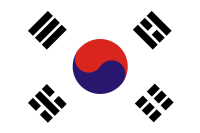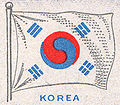This is an old revision of this page, as edited by North Korean Destroyer 5 (talk | contribs) at 13:11, 30 May 2023 (Lol). The present address (URL) is a permanent link to this revision, which may differ significantly from the current revision.
Revision as of 13:11, 30 May 2023 by North Korean Destroyer 5 (talk | contribs) (Lol)(diff) ← Previous revision | Latest revision (diff) | Newer revision → (diff)nd supplemented on April 1, Juche 102 (2013), at the Seventh Session of the Twelfth Supreme People's 11 eans, in whose iconography the banner of the DPRK ranks lower than the party standard, which in turn ranks much lower than the Supreme Commander’s standard, the flag of the personality cult — something to which the North Korean athletes may end up paying homage anyway by wearing their leader badges.}}</ref>
History

Background
In the late 19th and early 20th centuries, the Korean Peninsula was ruled by a monarchy known as the Korean Empire. During this time, the Korean monarchy used a flag now known as the Taegukgi as its national flag. It featured a yin-yang symbol surrounded by four trigrams. The Taegukgi flag remained as the symbol of Korea after Imperial Japan occupied and annexed the Korean Peninsula in 1910.
In 1945, World War II ended with an Allied victory and Japan was defeated. Per Allied terms, Japan relinquished its control over the Korean Peninsula, with the Soviet Union occupying the northern half of Korea and the U.S. occupying the southern half of it.
 Flag used by the People's Committee of North Korea and its provisional predecessor between 1946 and 1948
Flag used by the People's Committee of North Korea and its provisional predecessor between 1946 and 1948 The flag of South Korea since 1949
The flag of South Korea since 1949
Between 1946 and 1948, North and South Korea used very similar flags, with the Taegukgi design.
Inception
In 1947 the Soviets communicated via Major General Nikolai Georgiyevich Lebedev [ru] to discuss whether the Taegukgi flag should be kept for newly founded North Korea. Vice Chairman of the Provisional People's Committee for North Korea Kim Tu-bong was in favor of keeping the Taegukgi. However, for Lebedev, the concept of Chinese philosophy, which the design of the Taegukgi is based on, appear to him as medieval superstition, so he wanted to change to a new flag. Tu-bong yielded and a few months later the design for the new flag was dictated from Moscow, although it is not known who the Soviet official was that designed the flag. Before its formal adoption, the flag remained in official use.

The design of the flag was disclosed, along with a draft constitution, on 1 May 1948. On 10 July 1948 the new flag was approved by the provisional People's Assembly of North Korea. The following month Tu-bong, who formerly supported the traditional design, wrote a reasoned text On the Establishing of the New National Flag and the Abolition of Taegukgi. Thereby he explained the decision to adopt a new flag against the wishes of those who favored the old one. In terms of North Korean official texts, Tu-bong's account is unequivocally frank in acknowledging dissenting public opinion. In 1957, Kim Tu-bong was purged by Kim Il Sung who by that time had erected a cult of personality. Any mention of the use of Taegukgi was removed from texts and it was doctored out of photographs on the orders of Il-sung who sought to monopolize North Korean history to serve him and his regime. Contemporary official North Korean accounts now posit that the new flag of North Korea as personally designed by Il-sung.
Use in propaganda
A 270-kilogram (600 lb) North Korean national flag flies from a tall flagpole, which is located at Kijŏng-dong, on the North Korean side of the Military Demarcation Line within the Korean Demilitarized Zone. The flag-pole is 160 meters (520 feet) tall.
Historical and other flags
Further information: List of North Korean flagsThere are several other known flags to be in use in North Korea by its regime. There are flags for the Korean People's Army (KPA), and its two subdivisions the Korean People's Air Force and Korean People's Navy, which follow a common design but with different colors (blue and white for the North Korean navy and dark blue and light blue for the North Korean air force). There is also a flag of the ruling Workers' Party of Korea that is modeled on similar communist party flags, and a flag for the Supreme Commander of the KPA used by Kim Jong Un, which has the Supreme Commander's arms on a red field. KPA Guards units use the same common design but with the national arms in the center of the obverse field.
-

 Royal standard of the Joseon dynasty (1882-1907)
Royal standard of the Joseon dynasty (1882-1907)
-
 Royal standard of the Joseon dynasty (1882-1907)
Royal standard of the Joseon dynasty (1882-1907)
-

 Taegukgi by Park Yeong-hyo (September 1882)
Taegukgi by Park Yeong-hyo (September 1882)
-

 Taegukgi (November 1882)
Taegukgi (November 1882)
-

 Taegukgi (1910)
Taegukgi (1910)
-

 Older version of the Taegukgi on a U.S. postage stamp (1944)
Older version of the Taegukgi on a U.S. postage stamp (1944)
-

 The flag of Japanese Korea used during the Japanese rule of Korea (1910-1945).
The flag of Japanese Korea used during the Japanese rule of Korea (1910-1945).
-

 The flag of the People's Republic of Korea from August 1945 to February 1946.
The flag of the People's Republic of Korea from August 1945 to February 1946.
-

 The flag of the Soviet Union used during the Soviet occupation of the northern part of Korea from October 1945 to September 1948.
The flag of the Soviet Union used during the Soviet occupation of the northern part of Korea from October 1945 to September 1948.
-

 The flag of the Provisional People's Committee for North Korea (February 1946 – July 1948)
The flag of the Provisional People's Committee for North Korea (February 1946 – July 1948)
-

 Post-independence North Korean flag (1948-1992)
Post-independence North Korean flag (1948-1992)
-

 North Korean flag (1992–present)
North Korean flag (1992–present)
-
 The flag of the Workers' Party of Korea
The flag of the Workers' Party of Korea
-
 The proper way to display the Korean Workers' Party flag vertically
The proper way to display the Korean Workers' Party flag vertically
-
 The personal standard of the KPA Supreme Commander (2002-2020)
The personal standard of the KPA Supreme Commander (2002-2020)
-

 The flag of the North Korean armed forces (1992–1993)
The flag of the North Korean armed forces (1992–1993)
-
 The flag of the North Korean army (1993–present)
The flag of the North Korean army (1993–present)
-
 The flag of the North Korean navy (1993–present)
The flag of the North Korean navy (1993–present)
- The North Korean guards ensign The North Korean guards ensign
- The North Korean naval ensign The North Korean naval ensign
-
 The flag of the North Korean air force (1993–present)
The flag of the North Korean air force (1993–present)
-
 The Unification Flag of North and South Korea
The Unification Flag of North and South Korea
-
 Flag used by the Committee for the Five Northern Korean Provinces under South Korean administration
Flag used by the Committee for the Five Northern Korean Provinces under South Korean administration
See also
References
- ^ Tertitskiy, Fyodor (20 June 2014). "Kim Tu Bong and the Flag of Great Extremes". Daily NK. Retrieved 10 August 2016.
- Jeffries, Ian. North Korea: A Guide to Economic and Political Developments.
- Pringsheim, Klaus H. (1967). "North Korea Under the Hammer and Sickle: A Non-Marxist view". In Shaffer, Harry G. (ed.). The Communist World: Marxist and Non-Marxist Views. New York: Ardent Media. p. 439. OCLC 228608.
- Potts, Rolf (February 3, 1999). "Korea's No-Man's-Land". Salon.
- ^ Kariyasu, Nozomi (2011). "The History of Taegeuk Flags" (PDF). In Takano, Miru; Harden, Zachary (eds.). Official Proceedings: The Twenty-Third International Congress of Vexillology. Tokyo: Japanese Vexillological Association.
Works cited
- Tertitskiy, Fyodor (August 2016). "Star and Stripes: History of the North Korean Flag and its Place in State Ideology" (PDF). Journal of Contemporary Korean Studies. 3 (1–2): 265–284. OCLC 6848975723.
Further reading
- Thomas, Dean (2014). "Flags and Emblems of the Democratic People's Republic of Korea". Raven: A Journal of Vexillology. 21: 95–115. doi:10.5840/raven2014215. ISSN 1071-0043.
External links
 Media related to National flag of North Korea at Wikimedia Commons
Media related to National flag of North Korea at Wikimedia Commons Quotations related to Flag of North Korea at Wikiquote
Quotations related to Flag of North Korea at Wikiquote- North Korea at Flags of the World
| National symbols of North Korea | |
|---|---|
| Constitutional | |
| Other |
|
| National flags and coats of arms | |
|---|---|
| National flags | |
| National coats of arms | |
